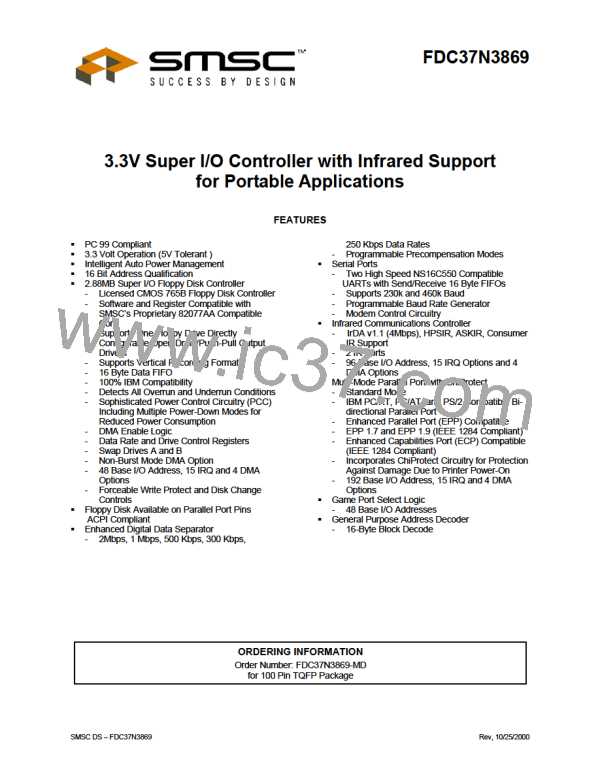nCLKRUN is an open drain output and an input. Refer to the PCI Mobile Design Guide Rev 1.0 for a description of
the nCLKRUN function.
USING NCLKRUN
If nCLKRUN is sampled “high”, the PCI clock is stopped or stopping. If nCLKRUN is sampled “low”, the PCI clock is
starting or started (running). If a device in the FDC37N3869 asserts or de-asserts an interrupt and nCLKRUN is
sample “high”, the FDC37N3869 can request the restoration of the clock by asserting the nCLKRUN signal
asynchronously Table 74). The FDC37N3869 holds nCLKRUN low until it detects two rising edges of the clock. After
the second clock edge, the FDC37N3869 must disable the open drain driver (Figure 7).
The FDC37N3869 will not assert nCLKRUN under any conditions if SIRQ_EN is inactive (“0”). The SIRQ_EN bit is
D7 in CR29.
The FDC37N3869 must not assert nCLKRUN if it is already driven low by the central resource; i.e., the PCI CLOCK
GENERATOR in Figure 6. The FDC37N3869 must not assert nCLKRUN unless the line has been deasserted for two
successive clocks; i.e., before the clock was stopped (Figure 7).
Table 74 - FDC37N3869 nCLKRUN Function
INTERNAL (PARALLEL)
INTERRUPTS
X
SIRQ_EN
nCLKRUN
ACTION
1
0
X
X
0
None
None
None
NO CHANGE
CHANGE1
1
Assert nCLKRUN
Note1: “Change” means either-edge change on any or all parallel IRQs routed to the SIRQ block. The
“change” detection logic must run asynchronously to the PCI Clock and regardless of the SIRQ
mode; i.e., “continuous” or “quiet”.
MASTER
TARGET
PCI CLOCK
PCICLK
FDC37N869
GENERATOR
nCLKRUN
(Central Resource)
FIGURE 6 - nCLKRUN SYSTEM IMPLEMENTATION EXAMPLE
SMSC DS – FDC37N3869
Page 95
Rev. 10/25/2000

 SMSC [ SMSC CORPORATION ]
SMSC [ SMSC CORPORATION ]